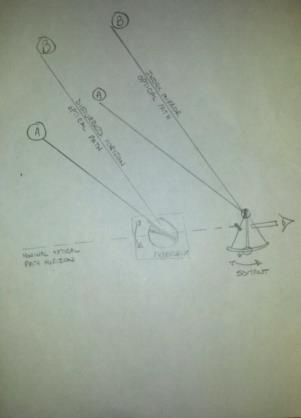
NavList:
A Community Devoted to the Preservation and Practice of Celestial Navigation and Other Methods of Traditional Wayfinding
From: Brad Morris
Date: 2014 Jan 27, 01:07 -0500
With apologies to Peter, I have started a separate thread for his 3d printed Hirth interface 'sextant'.
Its an interesting topic, but has little to do with centering error measurement and detection. Its easy to start a new thread, just modify the topic/subject line.
+++++
I would like to obtain feedback on the optical path in the email below. Its a simple method that uses an ultra precise circle division and compares the sextant under calibration to it.
If you have concerns or comments (on this topic), please share them with me.
If you want to talk about something else, can I please request that you start a new thread? In the absence of publicly available certification laboratories, this service is important to our craft and deserves our attention.
Brad
Gentlemen
Please examine the attached rough sketch
The Ultradex is placed such that the center of rotation is nominally in the center of the FOV of the horizon optical path. It will disturb the path to the same angle as the index path. See AA and BB
In practice then, we would essentially use the sun or moon, and perform the standard index error measurement, albeit at other angles along the arc, say 15°, 30°, 45° etc (this is limited only by the step size of the Ultradex. For mine, this would be every 1° actual rotation of the Ultradex OR 2° of disturbed path).
The alignment of the Ultradex is not super critical for the following rational. We make every effort to insure that at 0°, the index, we have both paths aligned to perfection, the index error at zero is well established in the community. After determining the errors all along the arc, *normalize* (arithmetically shift) the curve up or down. For those more adept arithmetically, the fitted error curve should cross at 0° (the index). OR since the error just a few degrees away from the index should also be close to zero, just make the actual error curve cross zero there.
Viola. Arc (Centering) Error measured and established, without sending your sextant back in time to the Kew Observatory!
This works because the Ultradex is ultra precise. The disturbed horizon path is shifted by precise incremental angles, with a precision about 10x our finest sextant resolution.
Note that this will work for a huge range of angles, as the Ultradex can freely rotate through 360°. So this will finally permit me to calibrate my Circle of Reflection.
Comments? Feedback?
Brad
On Jan 23, 2014 2:32 PM, "Brad Morris" <bradley.r.morris@gmail.com> wrote:Correct Örjan. Its a Hirth radial interface. From any one position to any other whole degree is accurate (for mine) to 0.5". The repeatability (for mine) is 1/20". Mine is divided into 360 parts (degrees). Its traceable to NIST (National Institute of Standards and Technology) and is calibrated within the last year. It is a spectacular piece of kit.
Bill, I've gone through your post. Yes, the Ultradex can take the place of the SNO-T and make short work of the motion from angle A to angle B. The motion takes just a few seconds of time (5-10, we want to treat the Ultradex with respect). In doing so, we have the accuracy and repeatability detailed above.
I'll make a sketch of the optical path I'm thinking of. Whilst I do have simultaneous access to a Nikon 6D Autocollimator, I would like to try to replicate the original patent. There is a fundamental reason. Last I checked, to purchase the Autocollimator and the Ultradex would cost > $40K. That puts the solution Örjan specified well out of the reach of many.
Patience, the sketch is coming!
Brad
On Jan 23, 2014 1:22 PM, "Örjan Sandström" <pokerbacken---.com> wrote:Uhm, i think you are both talking what I have been taught is Hirth Rings, accurate to better than 2 arcseconds and repeatable to 0.5 arcseconds.
A set of 720 tooth rings (two for each indexing platform) should do well as sextant test platform, add a autocollimator and you are set
should make short work of testing each degree to VERY accurate value, better than the readout of the sextant at any rate.
----------------------------------------------------------------
NavList message boards and member settings: www.fer3.com/NavList
Members may optionally receive posts by email.
To cancel email delivery, send a message to NoMail[at]fer3.com
----------------------------------------------------------------







